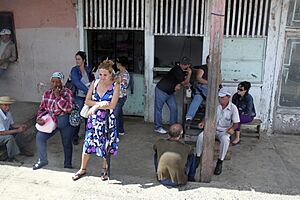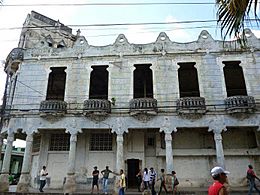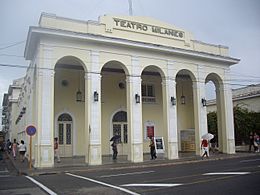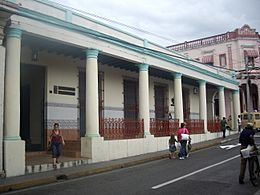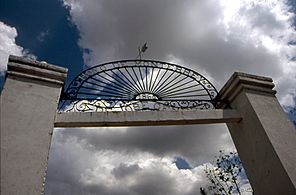Pinar del Río facts for kids
Quick facts for kids
Pinar del Río
|
||
|---|---|---|
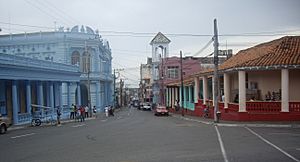 |
||
|
||
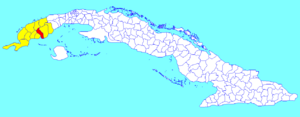
Pinar del Río municipality (red) within
Pinar del Río Province (yellow) and Cuba |
||
| Country | Cuba | |
| Province | Pinar del Río | |
| Founded | 1867 | |
| Area | ||
| • Municipality | 731 km2 (282 sq mi) | |
| • Urban | 70.7 km2 (27.3 sq mi) | |
| Elevation | 61 m (200 ft) | |
| Population
(2022)
|
||
| • Municipality | 191,081 | |
| • Density | 261.40/km2 (677.0/sq mi) | |
| • Urban | 156,643 | |
| • Rural | 34,438 | |
| Demonym(s) | Pinareños | |
| Time zone | UTC-5 (EST) | |
| • Summer (DST) | UTC-4 (EDT) | |
| Postal code |
20100-20300
|
|
| Area code(s) | +53 48 | |
| Vehicle registration | P | |
| Highways | Carretera Central | |
Pinar del Río is an important city in Cuba. It is the capital of the Pinar del Río Province. In 2022, about 191,081 people lived there. This makes it the 10th largest city in Cuba. People from Pinar del Río are called Pinareños.
Contents
History of Pinar del Río
Pinar del Río was one of the last big cities in Cuba that the Spanish founded. This happened on September 10, 1867. The city and province were first called Nueva Filipinas. This name was given because many workers from the Philippines came to work on tobacco farms.
Before the Spanish arrived, two main groups of people lived here. The Guanahatabey were nomadic people. They lived in caves and got most of their food from the sea. They were peaceful and different from other native groups. The Ciboney people also lived in this area. They were a part of the Taino people. The Guanahatabey people were gone by the time the Spanish came in 1492. We don't know much about their society. However, some old sites have been found on the Guanahacabibes Peninsula.
After Christopher Columbus arrived, the Spanish didn't pay much attention to Pinar del Río. The area grew slowly. Later, people from the Canary Islands started to arrive in the late 1500s. These people became the first tobacco farmers in the region. The area was renamed Pinar del Río in 1778. This name likely came from the many pine forests along the Río Guama.
Tobacco farms and cattle ranches quickly grew in the rich soil. Farmers who grew tobacco were called Guajiros. This is a local word meaning 'one of us'. By the mid-1800s, people in Europe loved Cuban tobacco. The region became very successful. New sea routes opened up. In 1893, railways were built to help ship the tobacco. Pinar del Río is now known as "the Mecca of tobacco."
Geography and Climate
The city of Pinar del Río is located in western Cuba. It shares borders with other towns. These include San Luis, San Juan y Martínez, Viñales, and Consolación del Sur. Smaller villages like La Coloma are also part of the municipality.
Climate in Pinar del Río
Pinar del Río has a warm tropical climate. It is known as a tropical monsoon climate. This means it has hot weather all year. It also has a wet season and a dry season.
| Climate data for Pinar del Río | |||||||||||||
|---|---|---|---|---|---|---|---|---|---|---|---|---|---|
| Month | Jan | Feb | Mar | Apr | May | Jun | Jul | Aug | Sep | Oct | Nov | Dec | Year |
| Mean daily maximum °C (°F) | 27.0 (80.6) |
27.0 (80.6) |
29.0 (84.2) |
30.0 (86.0) |
31.0 (87.8) |
31.0 (87.8) |
32.0 (89.6) |
32.0 (89.6) |
32.0 (89.6) |
30.0 (86.0) |
29.0 (84.2) |
27.0 (80.6) |
29.8 (85.6) |
| Mean daily minimum °C (°F) | 17.0 (62.6) |
17.0 (62.6) |
18.0 (64.4) |
20.0 (68.0) |
21.0 (69.8) |
23.0 (73.4) |
23.0 (73.4) |
23.0 (73.4) |
22.0 (71.6) |
21.0 (69.8) |
19.0 (66.2) |
18.0 (64.4) |
20.2 (68.3) |
| Average rainfall mm (inches) | 56.0 (2.20) |
65.0 (2.56) |
74.0 (2.91) |
78.0 (3.07) |
190.0 (7.48) |
260.0 (10.24) |
161.0 (6.34) |
208.0 (8.19) |
221.0 (8.70) |
129.0 (5.08) |
75.0 (2.95) |
40.0 (1.57) |
1,557 (61.29) |
| Average rainy days | 6.0 | 6.0 | 5.0 | 6.0 | 11.0 | 15.0 | 13.0 | 14.0 | 16.0 | 12.0 | 7.0 | 6.0 | 117 |
| Mean monthly sunshine hours | 217.0 | 226.0 | 248.0 | 270.0 | 248.0 | 210.0 | 248.0 | 248.0 | 210.0 | 217.0 | 210.0 | 217.0 | 2,769 |
| Percent possible sunshine | 64 | 73 | 67 | 69 | 62 | 54 | 62 | 62 | 58 | 58 | 64 | 64 | 63 |
| Source: Weather Atlas | |||||||||||||
Population and Economy
In 2002, a study showed that the city of Pinar del Río had about 152,200 people. The whole area, including the city and nearby rural parts, had 189,221 people. The total area of the municipality is about 708 square kilometers. By December 2022, the population grew to 191,081 people.
Economy of the City
Pinar del Río is in a big tobacco-growing region. This means it's a major center for making cigars. Many people work in the tobacco industry here. The main farming animal in this province is the carabao, a type of water buffalo.
Sports and Transport
Sports in Pinar del Río
The city has a popular baseball team called Pinar del Río. Their nickname is Vegueros. They play their home games at the Capitán San Luis Stadium. The Vegueros even won the Serie del Caribe championship in 2015. There is also a football (soccer) team, FC Pinar del Río, which plays at the same stadium. Famous baseball player Tony Oliva, who is in the Major League Baseball Hall of Fame, is from Pinar del Río.
Getting Around Pinar del Río
The city is connected by major roads. These include the Carretera Central highway and the A4 motorway. There is also a train station that connects to Havana. While there are two airports nearby, Pinar del Río Airport and La Coloma Airport, they do not have regular flights.
Education
The main place for higher education in the city is the University of Pinar del Río. Students can go there to study many different subjects after high school.
Notable People from Pinar del Río
- Danys Báez – a baseball pitcher
- Mario Bencomo – a painter
- René Capo – an Olympic Judo athlete
- Willy Chirino – a singer and songwriter
- Jose Contreras – a baseball pitcher
- Sen Dog – a member of the music group Cypress Hill
- Yunieski Gonzalez – a boxer
- Dagoberto Valdés Hernández – a religious leader and writer
- Carlos Luna – an artist
- Mijaín López – a five-time Olympic Greco-Roman Wrestling champion
- Eugenio Martínez – a political activist
- Yunesky Maya – a baseball pitcher
- Polo Montañez – a singer and songwriter
- Dolan Mor – a writer
- Pedro Pablo Oliva – a painter
- Tony Oliva – a baseball outfielder and Hall of Famer
- Paulina Pedroso – a leader in the Cuban War of Independence
- Rudy Pérez – a composer
- Alexei Ramírez – a baseball infielder
- Yoel Romero – a Mixed Martial Artist and Olympic wrestler
- Gonzalo Rubalcaba – a pianist
- Eduardo Zamacois – a novelist
Gallery
See also
 In Spanish: Pinar del Río para niños
In Spanish: Pinar del Río para niños



